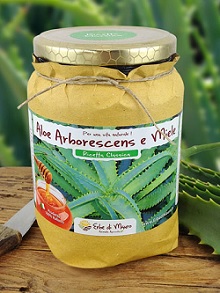Can Aloe juice be toxic for our body? Are there any possible contraindications due to the internal and external use of Aloe Vera and Aloe Arborescens? In which cases is it not recommended?
Even natural products have contraindications
Aloe is an extraordinary plant, used for thousands of years in traditional medicine, for the treatment of an extensive number of pathologies, even very serious ones.
In his book “Cancer can be cured”, Father Romano Zago exalts the Aloe healing properties, reporting his personal experience in the use of this plant, for the treatment of thousands of patients, especially Cancer patients.
However, even if it is a natural remedy, Aloe, if taken internally, can have some contraindications and almost always presents side effects (which, however, is the result of the depurative action of this plant) .
Aloe juice to drink: Contraindications
In some cases, the intake of Aloe Vera juices or Aloe Arborescens is totally contraindicated.
In others, it is possible to opt for products that do not contain aloin, a laxative substance, which can be irritating and deleterious for subjects with intestine and/or colon inflammatory problems.
We should also consider possible pharmaceutical interactions.
Finally, there are the so called natural side effects, which are the result of the normal purifying effect that you are going through when drinking the Aloe juice.
We will now analyze case by case.
1. Always avoid Aloe if …
There are circumstances in which Aloe Vera, or Arborescens, taken as a drink should always be avoided.
The cases in question are:
- Pregnancy: Aloe juice can cause uterine contractions and spontaneous abortions, so avoid oral intake during the whole pregnancy period;
- Breast-feeding: Aloe makes bitter and unpleasant mother’s milk on the palate of the child;
- Intolerances, or personal allergies: even if rare, there are a few cases of intolerance, or even allergy to the Aloe. In order to find out if you are intolerant to this plant, Father Zago suggests this simple trick: cut a piece of leaf and apply it on the skin behind the ear, or under the armpit for about 2 minutes. If the part in which the application was made is inflamed, it means that you are Aloe intolerant. You can do the same using ready-made juice, or creams based on Aloe.
2. You can take it, but aloin free

The aloin is an anthraquinone glucoside with marked laxative properties, present in the peel and in the outer part of the gel of the Aloe Vera and Aloe Arborescens leaves.
This substance is used by the pharmaceutical industry to produce purgative powders and tablets. These substances should be taken only under strict medical advice, because they can be particularly irritating to the intestine and an overdose can be even toxic.
The aloin, if taken in small doses, is not toxic, but in predisposed subjects, can cause irritation and inflammation of the intestinal walls and in particular of the colon.
People suffering from inflammatory bowel diseases, such as:
- colitis;
- ulcerative colitis;
- Crohn’s disease.
should avoid the intake of this substance, instead choosing filtered Aloe juices, which in the package are labeled “aloin free”.
The pure aloe gel, deprived of aloin, is not harmful in these cases, yet it is even recommended. In fact, the gel contains substances (acemannane and mucilage), which have an anti-inflammatory and protective effect against the entire gastro-intestinal tract.
3. Drug interactions
Aloe can interact with some drugs, enhancing or reducing their effects. For this reason, if you are taking medication, I highly recommend that you consult your doctor before taking juices, or other products based on Aloe Vera, or Arborescens.
Here are some drugs with which Aloe can have interactions:
- anti-arrhythmic drugs;
- medications with cardiac glycosides;
- diuretic drugs;
- corticosteroids.
Contraindications in Diabetes
A separate consideration must be made for diabetes.
As documented by several scientific studies, Aloe can reduce blood sugar, so it has a positive effect on diabetics. For this reason, however, attention should be given by those who take drugs such as insulin or glucose tablets.
Aloe can be taken by the diabetic, but one should consult his doctor to reduce the amount of the drug from time to time, in order to avoid dangerous hypoglycemia.
Contraindications for the thyroid

Aloe has an immunomodulatory and anti-inflammatory effect that can be very useful in the treatment of thyroid disorders and in particular in autoimmune diseases, such as Hashimoto’s thyroiditis.
However, many doctors advise against the internal use of Aloe Vera juices, or Aloe Arborescens, in the case of subjects suffering from hypothyroidism, in treatment with drugs such as Eutirox, or similar.
The problem apparently is that Aloe would reduce the absorption of levothyroxine, the active ingredient in Eutirox.
So even in this case, always consult your doctor before taking Aloe juice.
4. Unwanted side effects
Even in healthy subjects the intake of Aloe juice, more specifically of homemade juice made following the original recipe of Father Zago (then with the peel and with the aloin), can cause unwanted effects.
However, as explained by Father Romano Zago in his book, these are temporary hassles, which do not last longer than 4-5 days and are the result of a non-negative but curative reaction.
Through these reactions, Aloe cleanses our body, freeing us of toxins, heavy metals and other waste products.
Here are some of the most common “side effects” due to Aloe juice intake:
- Skin reactions: rash, boils, abscesses, pruritus, blisters, etc.
- Intestinal disorders: diarrhea, flatulence, feces with unpleasant odor, etc.;
- Urine: increased diuresis, dark urine, pink urine;
- Other rare reactions: vomiting.
In any case it is possible to reduce side effects by halving the dosage of intake of the recipe.
Contraindications for children

There is no absolute answer to this question. Generally speaking, all doctors agree in advising against Aloe for internal use, to children less than a year old.
The most cautious doctors advise against the intake of Aloe Vera or Arborescens juice, even to children under 12 years.
However, in his book, Father Zago tells us about cases of very young children, who have taken his aloe recipe for the treatment of cancer diseases, with very positive results, among other things.
The most striking case is that of a child of just 15 months of life, recovered from a tumor thanks to the use of this juice.
Contraindications for external use
Aloe used externally, as pure gel extracted from the leaves, or as a cream, has no contraindications, except in those who are allergic to it.
In these cases, the person may notice clear reactions on the skin, such as redness, blisters, or itching.
All the others can instead use the Aloe Vera or Aloe Arborescens pure gel extracted fresh from the leaf, or creams and ointments based on Aloe.
Aloe Vera: Contraindications from chemicals
A negative side of many products based on Aloe Vera is the massive presence of additives, preservatives and unwanted chemicals, which in the long run can bring significant damage to our health.
Let’s see what these substances are and what is the issue:
Beware of preservatives
Aloe juices, like all long-life drinks, need to be treated with preservatives.
These are chemicals with antibacterial properties, added with the aim of blocking the growth of pathogenic bacteria and yeasts. All this guarantees a longer product life and an easier storage.
These are the most used synthetic additives (if you find them on the label):
- E211: sodium benzoate;
- E212: potassium benzoate;
- E213: calcium benzoate;
- E202: potassium sorbate;
- E300: ascorbic acid;
- E330: citric acid.
The “benzoate” additives are absolutely those with the highest toxicity compared to others. Overdosage of benzoate, in addition to poisoning the liver, over time can lead to undesirable effects such as allergies, hives, nausea, headache, asthenia, burns to the esophagus, etc.
Also ascorbic acid and citric acid are far from harmless, since in most cases they are produced in the United States. They are extracted from corn, from one of the world’s largest producers of GMO plants and seeds.
The advice is to avoid long-life products, opting instead for the juice prepared at home, or buying fresh products for short storage, which do not contain preservatives, possibly organic and produced in Italy .
Where to buy products without preservatives?
In Italy one of the few companies that grows and produces fresh Aloe juices is the Erbe di Mauro farm.
The farm cultivates both Aloe Vera and Aloe Arborescens plants and makes fresh juices according to the original recipe of Father Romano Zago, blending together the leaves of Aloe Arborescens, organic honey and a little grappa.
In addition, the company also produces pure juices of Aloe Vera, aloin free and filtered juices of Aloe Arborescens, even these aloin free.
The plants are cultivated in the soil, between the hills of Fermo and Monte San Giusto (Italy, Marche region). No chemical fertilizers, pesticides, or other chemicals harmful to the body are used and all juices are free of preservatives, thickeners, colorings or sugars.
As these are products with a short-term expiration date (one month, maximum one and a half months), the juices are freshly made to order.

Aloe Arborescens juice, Father Zago’s recipe
Ingredients: Aloe Arborescens, honey and distillate;
Content: 750 ml;
Price: 34,00 €;


